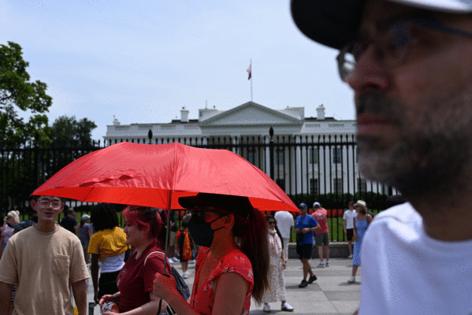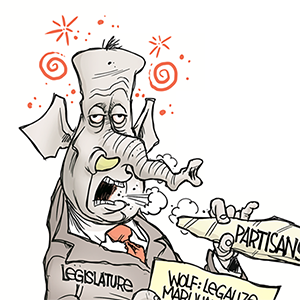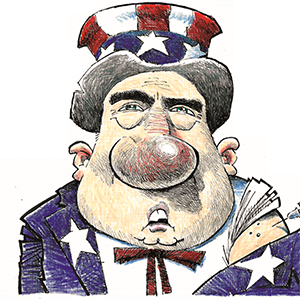With extreme heat ahead, US readiness appears to be on ice
Published in News & Features
WASHINGTON — Federal efforts to help people cope with extreme heat appear to be melting away even as the nation prepares for another summer of record high temperatures and increasing numbers of heat-related illnesses and deaths.
The heat is already on in much of the country, with highs in the 90s and 100s expected from coast to coast this week. The first-ever heat advisory in Alaska was issued by the National Weather Service last week, when the temperature rose above 80 in Fairbanks.
Expect more of the same throughout the summer: the National Oceanic and Atmospheric Administration predicts higher-than-average temperatures across the country, especially in July and August.
Government statistics show an average of 3,389 illnesses and 40 deaths caused by heat each year from 2011-20, but experts say the numbers are wildly underreported.
“If you were looking at death certificates, you may not see heat, but you may see a cardiovascular event or something, and so it’s undercoded,” said Jill Rosenthal, director of public health policy at the Center for American Progress. “If anything, the data undercounts how dangerous extreme heat is.”
A recent study by the center estimated that there are health care costs of $1 billion a year for hospital admissions and emergency room visits for treatment of heat stroke, heat exhaustion and other heat-related illnesses, and that doesn’t count the lost productivity among ailing workers, Rosenthal said.
Extreme heat can also strain the electrical grid, damage infrastructure such as railroad tracks, cause flight delays and reduce agricultural output, according to a March report by the Congressional Research Service.
The Occupational Safety and Health Administration at the Labor Department is still considering rules for protecting workers from extreme heat proposed last summer by the Biden administration, but Rosenthal and other health advocates doubt the Trump administration will make them final.
“We’re going on President Trump’s track record from his first term of not finalizing regulations, and also from his actions thus far in this administration, actions to eliminate the term climate change” from federal programs and regulations, Rosenthal said.
She also said many of the researchers who drafted the proposed regulations, including most of the staff at the National Institute for Occupational Safety and Health, have been forced out of their jobs. “So based on those factors, it seems very unlikely that they will finalize this regulation, not to mention the fact that it was proposed during the Biden administration,” she said.
“We are not confident that the current administration is going to put it in place,” agreed Juan Declet-Barreto, senior social scientist for climate vulnerability at the Union of Concerned Scientists. “The reason for dismantling or not putting into place a heat protection rule for workers is to bury the evidence on climate change.”
The OSHA rule proposed in August 2024 would require employers “to create a plan to evaluate and control heat hazards in their workplace,” including providing plenty of water and regular breaks to get workers out of the sun.
While the public comment period on the proposal officially ended in January, OSHA is still informally taking comments in virtual hearings each weekday through July 2, which Rosenthal said provides a glimmer of hope for final adoption.
She argued that federal regulations would help reduce the toll from extreme heat.
“Just requiring employers to have a heat plan, to train their workers, and to provide access to breaks and shade and water … those are all really critical ways that we need to be tracking and responding to heat,” Rosenthal said.
Legislation introduced
Rep. Yassamin Ansari, D-Ariz., introduced legislation this month aimed at addressing extreme heat, which she said caused more than 600 deaths last year in Maricopa County around Phoenix. Her figures for one Arizona county are far higher than the national average only a few years earlier, an indication of the discrepancies between local and national data.
One of Ansari’s bills would require a federal study of the financial costs of extreme heat, one would establish an urban heat mitigation grant program at the Department of Housing and Urban Development, and one would set up a National Integrated Heat Health Information System at NOAA “to improve extreme heat preparedness, planning, and response.”
Arizona’s two Democratic senators, Mark Kelly and Ruben Gallego, have introduced companion bills.
Prospects for passage are dim, however, with Republicans in control of both chambers of Congress focused more on cuts than expansions of government programs.
The House and Senate budget reconciliation plans also would rescind tax credits for energy efficiency projects established in the 2022 reconciliation law to help reduce cooling and heating costs in homes and businesses.
In the absence of federal action, health advocates are urging states and local governments to develop heat-mitigation programs.
One prominent example is a program in Phoenix that has trained first-responders on heat-related illnesses, provided more public cooling spaces and public drinking water and added shaded areas to the city’s infrastructure. “We’re on a positive trajectory. … We had a 20% drop in [heat-related] illnesses and deaths last year,” David Hondula, director of the Phoenix’s Office of Heat Response and Mitigation, said at a panel on Capitol Hill last week hosted by the Environmental and Energy Study Institute.
Last year, the Minnesota-based Network for Public Health Law released a guide for protecting workers from extreme heat, through programs such as employee training and monitoring, cooling measures and emergency response plans.
But the outlook is troubling for much of the nation this summer.
“We don’t want to be all doom and gloom, but we have a lot of reason to believe that it’s going to take a dire toll on people’s health and well-being,” said Declet-Barreto of the Union of Concerned Scientists.
“We have a diminished National Weather Service capacity. We have a federal government that is actively suppressing the evidence of climate change. We have a health services federal infrastructure that is not focused on any of this,” Declet-Barreto said.
“And then when disasters hit, you would have a diminished FEMA, a diminished HUD, to be able to assist people,” he said. “And President Trump has been very clear that responsibility for this will fall to the states, which is very, very worrisome, because we know very well that extreme weather disasters don’t respect political boundaries.”
©2025 CQ-Roll Call, Inc., All Rights Reserved. Visit cqrollcall.com. Distributed by Tribune Content Agency, LLC.







Comments